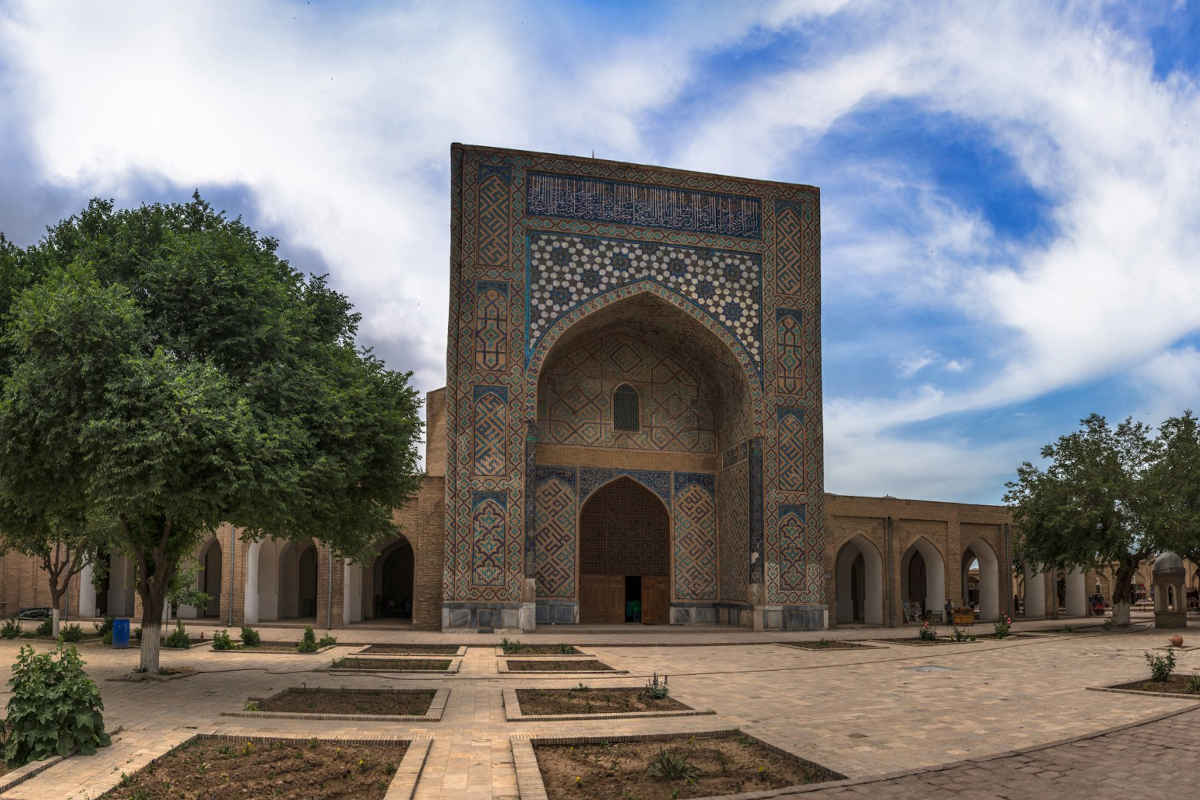Shakhrisabz - Kok Gumbaz Mosque

The Kok Gumbaz Mosque in Shakhrisabz: a masterpiece of Timurid architecture
The Kok Gumbaz Mosque in Shakhrisabz was built in 1435 on the orders of Ulugbek’s father, Shahrukh. This monumental Friday mosque was built on the foundations of a pre-Mongol building, the original layout of which was largely retained in the new structure. The mosque was part of the Dorut-Tilovat architectural ensemble and was located opposite the mausoleum of Shamsiddin Kulol, an important spiritual centre of the city.
The Kok Gumbaz Mosque was once adjoined by extensive summer galleries, the remains of which are still visible today. The massive bases of the square pylons, which once supported the large arches and above which numerous domes were raised, are particularly striking. Despite their age, these foundations have been preserved and bear witness to the former architectural splendour of the building.
Between the Dorus-Saodat and Dorut-Tilovat ensembles was a necropolis of the local nobility and clergy. Amidst the green gardens of Shakhrisabz rises the majestic blue dome of the mosque – Kok Gumbaz, which literally means ‘blue dome’. Due to its impressive size and central location, it is visible from almost every point in the city and forms an irreplaceable part of the city panorama.
The mosque was built on the initiative of Mirzo Ulugbek, the world-famous astronomer, mathematician, scholar and grandson of the legendary Amir Temur. He had the building erected in honour of his father Shahrukh. An inscription on the portal of the main entrance confirms this with the words that Ulugbek had the Kok Gumbaz Mosque built on his father’s instructions.
The mighty pylons of the east portal are decorated with elaborate ornamentation. The tympanum of the portal features the star-girikh mosaic motif typical of Ulugbek’s era, which is characterised by its mathematically precise symmetry. On the portal itself is an Arabic inscription praising the grandeur of this building: ‘This dome mosque is the most beautiful mosque in a high place; it has a large dome. This dome in Shakhrisabz resembles the blue sky above the green city.’
In the main pylons there are spiral staircases that lead up to the roof. These stairs provide access to a small guldasta tower, which is reminiscent of a minaret. The lower section of this tower is clad in the finest marble, while the upper section is crowned by a majolica capital. On the north and south facades of the mosque, open corridors lead into the interior of the building, which is characterised by its impressive architectural harmony.
The planners of the mosque aimed to maximise its height as much as possible so that the axis of the building was in line with the Kulol Mausoleum. This architectural decision gives the entire complex an extraordinary symmetry and visual balance. To ensure this harmonious overall appearance, the architects even had to modify the traditional orientation of the mosque – a deliberate deviation from the otherwise strict orientation towards Mecca.
The mosque’s striking blue dome is covered with sky-blue ceramic tiles, symbolising the cloudless sky and emphasising the spiritual grandeur of the building. From a distance, it appears to merge with the sky, creating an impression of lightness and floating. Around the base of the dome runs a circumferential band with ornate Quranic verses in elegant calligraphic script – a typical feature of the Timurid period. The inscription is particularly significant: ‘Power and wealth belong to Allah. Only Allah has dominion.’
When you enter the mosque, you immediately realise its monumental dimensions. The interior is square, which makes the dome look even more impressive. With a diameter of 46 metres, it rises majestically above the heads of visitors. The acoustics in this enormous space create a fascinating echo that multiplies voices and sounds in a mysterious way.
At the corners of the massive walls, four spiral staircases lead to the upper levels of the mosque and to the attic rooms. The walls inside are plastered with a fine layer of ganch – a mixture of plaster and clay that is known for its exceptional resistance. In some places, artistic, hand-painted ornaments in shades of blue and turquoise have been preserved, decorating the interior with intricate patterns.
The mihrab is located in the western niche of the mosque. It is decorated with ornate ganch stalactites, which create a particularly solemn impression thanks to their elaborate structure. The entire interior bears witness to the highest level of craftsmanship and the aesthetic sophistication that characterised Timurid architecture.
For several centuries, the Kok Gumbaz Mosque was the main jom mosque of Shakhrisabz. To the east of the mosque was a necropolis in Ulugbek’s time, where members of the nobility and clergy of the Barlas family, which included the Timurids, were buried. The marble tombstones bear the names of high-ranking commanders who took part in the campaigns of Shahrukh and Ulugbek.
The Kok Gumbaz Mosque in Shakhrisabz is one of the most impressive examples of Timurid architecture and an outstanding example of the harmonious combination of religious symbolism, mathematical precision and aesthetic elegance. Its majestic appearance still characterises the cityscape of Shakhrisabz today and makes it one of the most important architectural monuments in the region.
